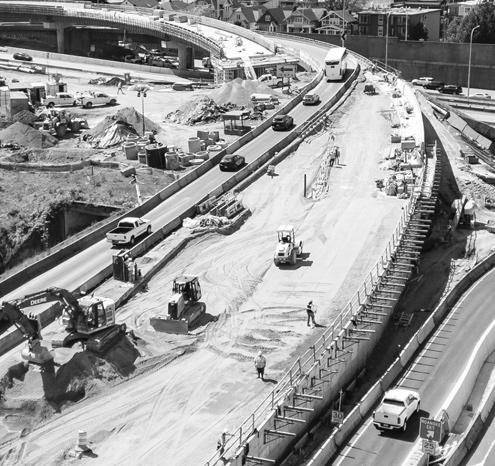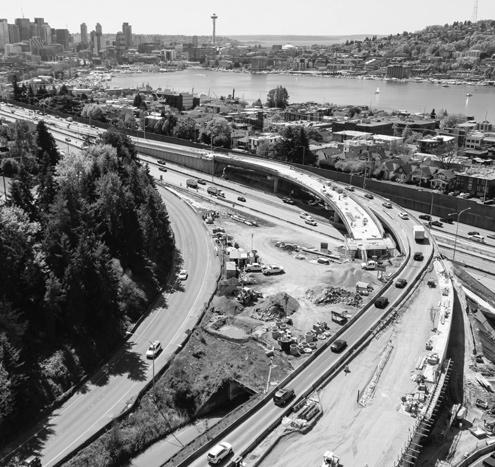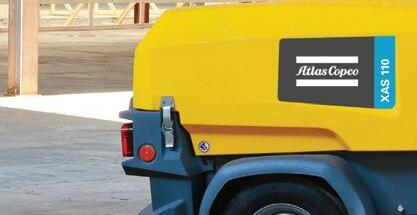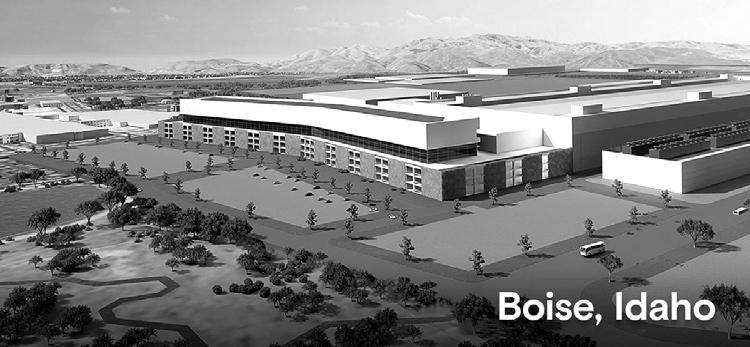






The Walsh Group is making steady progress on the Washington Department of Transportation’s SR 520 I-5 Express Lanes Connection Project.
Currently, construction crews are rebuilding and realigning the ramps to southbound I-5, northbound I-5 and Roanoke Street to make room for a reversible ramp connecting SR 520 to the I-5 express lanes.
“The Walsh Group is extending SR 520’s new transit/HOV system onto Interstate 5,” the contractor said in a statement. “Work includes construction of 23 retaining
see WEST page 8
Overall, the project is extending SR 520’s new transit/HOV system to I-5 by providing a dedicated, reversible connection between SR 520 and the I-5/Mercer Street interchange via the I-5 express lanes.



































































Mayor Harrell collaborated with the Seattle Department of Transportation (SDOT) to develop an 8-year, $1.35 billion draft transportation levy proposal to replace the existing Levy to Move Seattle expiring this year.
The draft proposal is based on the Mayor’s One Seattle initiative and the Seattle Transportation Plan (STP). Later this spring, the Mayor will finalize the Seattle Transportation Levy Proposal and send it to the City Council for consideration.
“Seattle residents want a transportation system that is safe, connected and well-maintained,” Seattle Mayor Bruce Harrell said. “This levy proposal will deliver more funding to get us there. No matter how you get around, it will make trips safer, more reliable, and better connected so that every Seattleite is set up for success when they experience our city. This is a top priority and will allow our transportation department to keep taking care of the essentials, be proactive stewards of our public assets, and keep the city working for you. We welcome your continued feedback and input — thank you.”
The proposal includes the total levy size, spending amounts for


The proposal includes the total levy size, spending amounts for each SDOT program, and details about the major capital project candidates.
each SDOT program, and details about the major capital project candidates.
Proposed program spending includes:
• $423M to repave and improve streets that carry the most buses, trucks, cars and make it safer for everyone to walk, roll, bike and ride transit;
• $218M to keep bridges in good and reliable working condition and prepare for future bridge projects;
• $121M to connect people safely to
transit hubs, including Link light rail stations; improve bus stops; and reduce delays on bus routes.
• $109M to build and repair sidewalks, crossings and curb ramps so people walking and rolling can safely get to where they need to go.
• $107M to reduce traffic collisions, severe injuries and fatalities through targeted improvements to streets, sidewalks, intersections, paths and crossings;
• $100M to install new and maintain and upgrade traffic signals for safe, reliable movement; improve pedestrian and bike accessibility; and support traffic operations during large events and for trips in and out of the port;
• $94M to expand Seattle’s protected bike lane network; connect schools to bike lanes, paths and neighborhood greenways; and maintain and upgrade existing bike lanes;
• $57M to make public spaces more inviting and improve lighting so people can enjoy unique and vibrant neighborhoods and business districts;
• $49M to address climate change directly, reducing air pollution and making sustainable transportation options more available;
• $48M to build projects that are co-created with community, focusing on neighborhoods with historical underinvestment.
• $25M to Make freight improvements to support trucks delivering goods and providing services. (All photos courtesy of Seattle Department of Transportation.)
Umatilla County, Ore., has partnered with one.network and Drivewyze to enhance road safety and efficiency across its transportation network.
This partnership represents a significant leap forward in the endeavor to modernize roadway and work zone management, promising to set new benchmarks for safe and efficient transport.
“For the first time in the U.S., road crews will be able to communicate directly with truckers through our Live Link app, relaying comprehensive, timely, and vetted work zone information via Drivewyze’s Smart Roadways software,” said Simon Topp, chief commercial officer of one.network. “This ensures that freight operators are equipped with the most accurate information, delivered when and how they need it most.”
Highlights of the partnership include:
• Real-Time Incident Notifications: Umatilla County can now provide instant alerts for various incidents, including accidents, road closures, and other disruptions. This feature is crucial for timely communication to both authorities and the public.
• Work Zone Safety Enhancement: The partnership emphasizes work zone safety and enables automated notifications about
ongoing construction activities and lane closures. This effort is geared toward minimizing inconvenience for commuters and enhancing safety for workers.
• Weather-Related Closures Alerts: Integration with meteorological data sources allows the system to issue alerts for adverse weather conditions, leading to more effective management of road safety during challenging weather scenarios.
• Emergency Notifications Capabilities: The platform facilitates swift communication during emergencies and natural disasters, ensuring that relevant stakeholders are informed promptly.
• Comprehensive Data Integration: The partnership leverages Geographic Information System (GIS) integration to visualize incidents and closures on maps, offering a clear overview for better decisionmaking.
This six-month pilot program is centered on showcasing the effectiveness and benefits of both one.network and Drivewyze’s industry-leading technology. This pilot program is
“Rural road safety begins with robust, actionable data.”
Dan Dorran
Umatilla County Commissioner
designed to comprehensively implement one.network’s traffic management planning and communication tool across Umatilla County. This strategic implementation is aimed at optimizing traffic management and enhancing communication capabilities for road events. Additionally, the deployment of one.network’s Live Link application is a pivotal aspect of this program, offering realtime updates on road closures, thereby significantly improving responsiveness and situational awareness. Furthermore, the program incorporates Drivewyze’s dynamic alert system, which is instrumental in providing timely and accurate notifications for active work zones and closures. This multifaceted approach in the pilot program is set to transform the management and safety of
Umatilla County’s transportation network.
Anticipated outcomes for Umatilla County include:
• Enhanced Road Safety: The initiative significantly reduces accidents and fatalities by proactively identifying and mitigating potential safety hazards;
• Operational Efficiency: Improved traffic flow and optimized routes lead to reduced operational costs and increased efficiency for transportation stakeholders;
• Data-Driven Decision Making: Access to comprehensive data analytics empowers decision-makers with valuable insights, facilitating strategic planning and policy formulation.
“Rural road safety begins with robust, actionable data,” said Dan Dorran, Umatilla County commissioner. “There was no preexisting model for us to emulate that could meet our unique needs for both safety and transportation efficiency. Thanks to this partnership, we’re now turning our vision of digitizing rural roads for the 21st century into reality, setting a precedent for rural communities nationwide.”
For more information, visit us.one.network








Construction crews are making headway on the Washington Department of Transportation’s $68 million SR 520 I-5 Express Lanes Connection Project in Seattle.
WEST from page 1
walls; five ramps [full depth replacement of the roadway cross section, utilities and walls]; a new, three-span steel girder bridge; and reconfiguring an existing southbound offramp to be reversible [full depth replacement, alignment adjustment, concrete barriers and soldier pile walls].”
This project — valued at $68 million — is extending SR 520’s new transit/HOV system to I-5 by providing a dedicated, reversible connection between SR 520 and the I-5/Mercer Street interchange via the I-5 express lanes. The new reversible lane will work in concert with the I-5 express lanes. When the I-5 express lanes are operating in the northbound direction, the new ramp will connect to eastbound SR 520. The new ramp will connect westbound SR 520 vehicles to the I-5 express lanes when they are operating in the southbound direction.
This project is part of the $2 billion in SR 520 improvements from Lake Washington to I-5 — the “Rest of the West.” These improvements are funded by the 2015 Connecting Washington and 2022 Move Ahead Washington transportation legislation packages.
Overall, the project encompasses:
• Building a new, reversible transit/HOV ramp between SR 520 and the I-5 express lanes;
• Restriping I-5 express lanes to retain the four existing lanes while adding a reversible transit/HOV lane between the

The new reversible lane will work in concert with the I5 express lanes. When the I-5 express lanes are operating in the northbound direction, the new ramp will connect to eastbound SR 520.
I-5/SR 520 interchange and Mercer Street;
• Modifying an existing ramp for reversible operations between the I-5 express lanes and Mercer Street.
This project is on track for a spring 2024 completion.
“When complete, this project will provide a reliable transit link between the region's major employment centers in Seattle's South Lake Union and the Eastside via SR 520,” said Program Administrator Omar Jepperson.
Over the last decade, Seattle’s population and employment boomed, especially in the South Lake Union neighborhood. At the same time, the Eastside’s technology-driven cities continued to see rapid growth. These two factors underscore the importance of a safe, reliable transit/HOV link between Seattle and the Eastside via SR 520. This project addresses this issue by creating a direct bus and carpool connection from SR 520 to South Lake Union and downtown Seattle.
This project is a central part of the larger, ongoing SR 520 Bridge Replacement and HOV Program to reconstruct the SR 520 corridor from I-405 in Bellevue to I-5 in Seattle. We’ve already completed several phases of the program, including:
• Floating Bridge and Landings Project: Built the world’s longest floating bridge across Lake Washington between Seattle and the Eastside, and constructed the bridge’s 44

When complete, this project will provide a reliable transit link between the region’s major employment centers in Seattle’s South Lake Union and the Eastside via SR 520.
smaller pontoons in Tacoma.
• Pontoon Construction Project: Built the floating bridge’s 33 largest pontoons in Tacoma and Aberdeen, Washington.
• Eastside Transit and HOV Project: Rebuilt the highway’s Eastside segment between I-405 and Lake Washington’s east shore.
• West Approach Bridge North Project: Completed the first of two parallel west approach bridges over Union Bay, between the floating bridge and Seattle’s Montlake neighborhood.
The Montlake Project, currently under construction, is completing the second of two parallel west approach bridges over Union Bay. This project includes building a new landscaped lid over the highway, and a bicycle and pedestrian bridge to the east of the lid.
When the corridor’s reconstruction is fully completed in the late 2020s:
• All of SR 520’s major bridges will be replaced with stronger structures.
• The bus/carpool lanes and a regional bicycle and pedestrian path will extend from Seattle east to Redmond
• Travelers will have safer on and off-ramps and improved connections to transit, local streets, and local and regional trail networks.
(All photos courtesy of Seattle Department of Transportation.)
The Slag Cement Association (SCA) announces the addition of CalPortland as its newest member company. CalPortland, the largest building materials company in the western United States, now joins SCA, bringing its extensive operations across Alaska, Washington, Oregon, California, Nevada, and Arizona. With a 130-year legacy of innovation,
CalPortland emphasizes the importance of sustainability and resilience in concrete construction. They advocate for sustainable construction materials, including the use of slag cement, in shaping the future of our built environment.
“We are excited to have CalPortland to join the Slag Cement Association,” stated Nick Brimley, Marketing Director of SCA.
“They are a strong advocate for the utilization of slag cement and their commitment to sustainable building practices aligns with SCA’s goal to reduce embodied carbon in our industry.”
The Slag Cement Association is a nonprofit trade association representing producers and suppliers of slag cement in the United States. Their membership repre-
sents over 95% of all slag cement produced and supplied in the country and includes industry leaders such as Argos, Ash Grove, CalPortland, Cemex, Dragon Products Company, Heidelberg Materials, Holcim, Ozinga, Skyway Cement Company, St Marys Cement, and WALAN Specialty Construction Products.




































The U.S. Department of Commerce and Micron Technology have signed a non-binding preliminary memorandum of terms (PMT) to provide up to approximately $6.14 billion in direct funding under the CHIPS and Science Act to boost U.S. competitiveness in leading-edge memory semiconductor production. The proposed funding would support the construction of two leading-edge Dynamic Random-Access Memory (DRAM) fabs, one of which would be in built in Boise, Ida.
The proposed funding would unlock a $25 billion investment in a DRAM fab in Idaho, which will be co-located with Micron’s R&D facilities in Boise and create approximately 6,500 facility and construction jobs. Together, these investments would advance the company’s plans to onshore approximately 40 percent of their DRAM chip production over the next two decades.
“Leading-edge memory chips are foundational to all advanced technologies. America is rebuilding its capacity to produce these critical capabilities for the first time in almost two decades,” said U.S. Secretary of Commerce Gina Raimondo. “With this pro-

posed investment, we are working to deliver on one of the core objectives of President Biden’s CHIPS program — onshoring the development and production of the most advanced memory semiconductor technology, which is crucial for safeguarding our leadership on artificial intelligence and protecting our economic and national security. With these proposed investments, coupled with Micron’s historic private investment of
up to $125 billion in New York and Idaho over the next 20 years, President Biden is working to revitalize U.S. technological leadership and creating tens of thousands of good-paying jobs.”
In Idaho, the plan is to develop a high-volume manufacturing (HVM) fab, with approximately 600,000 sq. ft. of cleanroom space focused on the production of leadingedge DRAM chips. The fab would be co-
located with the company’s R&D facility to improve efficiency across their R&D and manufacturing operations, reducing lags in technology transfer and cutting time-to-market for leading-edge memory products.
Micron is committing to spend $50 billion toward the development of their first three fabs over the next six years, spurring community revitalization and ecosystem development across the country. Over two decades, these projects are expected to create over 9,000 manufacturing and facility jobs and 4,500 construction jobs in New York, and over 2,000 manufacturing and facility jobs and 4,500 construction jobs in Idaho. Micron’s projects will operate under Project Labor Agreements (PLA) in New York and Idaho. Both PLAs emphasize workforce training through registered apprenticeships and hiring veterans and local workers. For example, the New York PLA includes a partnership with a local pre-apprenticeship program, which will prepare a diverse workforce for entry into construction trades, and the Idaho PLA includes measures to increase construction work by underserved communities.
Micron photo Rendering of the proposed Boise facility.

































